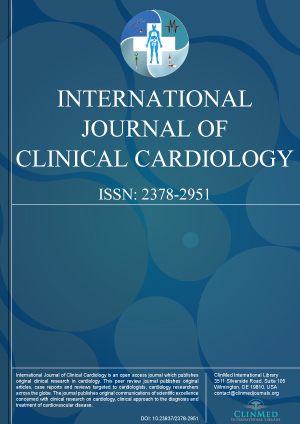Open Access DOI:10.23937/2378-2951/1410087
Validation and Simplification of a Scoring Model Derived for Prediction of Poor Coronary Collateral Circulation in Acute Non-St Elevation Myocardial Infarction
Mehmet İleri, Koray Gursel, Funda Basyigit, Pınar Turker Bayır, Deniz Sahin, Umit Guray, Ozgul Ucar, Burak Acer and Yahya Buyukasık
Article Type: Research Article | First Published: September 20, 2016
Determinants of coronary collateral circulation (CCC) in human heart are still incompletely identified. In acute non-ST elevation myocardial infarction (NSTEMI), abrupt vessel occlusion results in myocardial necrosis in the jeopardized area. Angiographic collaterals to myocardial tissue distal to an acutely occluded coronary vessel can reduce infarct size and risk for post-infarct complications as well as infarct related mortality. These prognostic implications of collateral function, makes it n...
Open Access DOI:10.23937/2378-2951/1410086
Coronary-Cameral Fistula Presenting as Worsening Refractory Heart Failure
Dhruti Mankodi, Ashish Sharma, Fulvia Banu, Sameer Shaharyar, Pedro Martinez-Clark and Ali Bazzi
Article Type: Case Report | First Published: August 12, 2016
Coronary-cameral fistula (CCF) is a rare condition most commonly caused by an embryologic developmental anomaly. Fifty-five percent of CCFs originate from the right coronary artery, 35% from the left coronary artery, and 5% from both. More than 90% of them drain into the venous system and low pressure sites such as the right ventricle (41%), right atrium (26%), pulmonary artery (17%) and only 3% drain into the left ventricle or atrium....
Open Access DOI:10.23937/2378-2951/1410084
Dilated Cardiomyopathy due to Vitamin D Deficiency
Nalan Karabayir, Kelesoglu E, Helen Bornau, Kazim Oztarhan, Aktas D and Erdem A
Article Type: Case Series | First Published: August 06, 2016
Dilated cardiomyopathy, which mostly has an idiopathic etiology or is caused by genetic inheritance or infection, may cause irreversible congestive heart failure. Hypocalcemia is a rare etiology of reversible dilated cardiomyopathy. Cardiogenic shock related to hypocalcemic cardiomyopathy is a rare event. Here we report two cases with congestive heart failure who was diagnosed as having dilated cardiomyopathy secondary to hypocalcemia....
Open Access DOI:10.23937/2378-2951/1410083
Successful Surgical Embolectomy for Acute Massive Pulmonary Embolism in Pregnant Woman
Nobuhiko Hiraiwa, Kohei Abe, Kunihiko Yoshino, Manabu Yamasaki and Hiroyasu Misumi
Article Type: Case Report | First Published: July 30, 2016
A 28-year-old pregnant woman was admitted to our hospital with tonic seizure and dyspnea, and was diagnosed with acute massive pulmonary embolism. An emergency surgical embolectomy was performed under cardiopulmonary bypass (CPB). Several fragments of the thrombi were carefully removed from the right and the main pulmonary arteries, and sufficient back-flow from the pulmonary artery was established. The postoperative course was uneventful. After the embolectomy, the ratio of pulmonary to systemi...
Open Access DOI:10.23937/2378-2951/1410081
Evaluation of Left Ventricular Systolic Function Immediately after Pulmonary Vein Isolation in Patients with Chronic Atrial Fibrillation using Speckle Tracking Echocardiography
Hisao Matsuda, Tomoo Harada, Yui Nakayama, Marika Yamada, Yasushi Takagi, Makoto Takano, Ikutarou Nakajima, Emi Nakano, Yukako Takimura, Satoru Nishio, Toshiyuki Furukawa, Hidekazu Miyazaki and Yoshihiro J Akashi
Article Type: Original Article | First Published: July 18, 2016
Background:The effect of pulmonary vein isolation (PVI) on left ventricular (LV) function after restoration of sinus rhythm remains unclear in patients with chronic atrial fibrillation (CAF). This study aimed to evaluate LV systolic function in the early phase after PVI using speckle tracking echocardiography.
Methods:Twelve patients with CAF could be restored to sinus rhythm by PVI and maintained sinus rhythm after PVI. Echocardiography was performed before, immediately after and 3 months afte...

